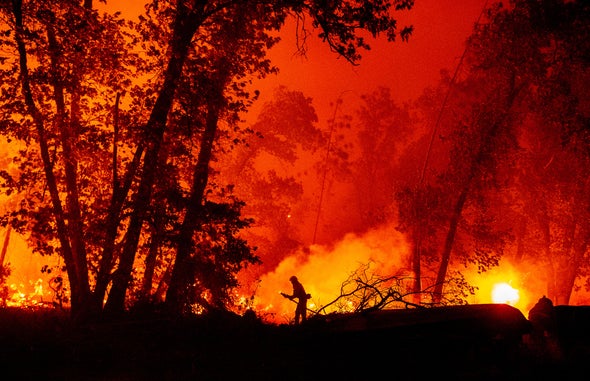A new analysis finds that dry air and record-breaking temperatures linked to climate change have led to more frequent severe fires in California

Climate change is a primary driver of escalating wildfires in California, with extreme temperatures and dry air spawning more intense burning, according to a UCLA study released Tuesday.
The study, published in the International Journal of Wildland Fire, drew from state and federal firefighting data and synthesized earlier reports on climate change and wildfire. Researchers examined fires between 1980 and 2020, along with the environmental changes during those four decades.
“Climate change is an overarching factor” in more severe blazes, said study author Glen MacDonald, a UCLA professor of geography and environmental sustainability. In particular, he said, research shows a “striking” relationship between the increase in air dryness and annual area burned.
The analysis arrives as State Farm, the biggest insurer in California, announced Friday that it would no longer insure new homes in the nation’s most populous state, citing wildfires and rebuilding costs. The UCLA study notes that 18 of the 20 largest fires in recorded California history occurred since 2003.
Between 2002 and 2020, California wildfires killed 302 people and destroyed more than 60,000 structures, according to the study. The worst of those infernos was the 2018 Camp Fire in Paradise, northeast of Sacramento, which left 85 residents dead.
The study points to record-breaking temperatures that have decreased the relative humidity of the atmosphere, increasing the occurrence of “vapor pressure deficit.” That deficit is the amount of moisture the air can hold versus how much it actually holds at a given time — and its presence is “an important predictor of wildfire potential in California and the rest of western USA,” according to the study.
That dry air “has been increasing in California at a statistically significant rate during the May–October warm season, a trend that is projected to continue,” researchers wrote. The analysis cites earlier research that estimated that 68 percent of the increase in vapor pressure deficit in the western United States between 1979 and 2020 is likely attributable to warming.
As the climate changes, winter precipitation is also becoming compressed into a shorter period “contributing to a lengthened fire season,” the study said. Warming has also accelerated snowmelt in the Sierra Nevada since the mid-20th century, researchers wrote.
The most significant change is the severity of fires, rather than their size, according to the study.
“So when the fire goes through, there is really high levels of vegetation destruction, or destruction of standing timber and trees,” MacDonald said. “The lower components of the vegetation, the herbs and the shrubs, as well as the tree canopy, [are] destroyed. That’s a high-severity fire.”
Asked about the State Farm announcement, MacDonald said California might need to reconsider where it allows the building of new homes. Many of the locations where extreme fires have burned are in what’s known as the “wildland urban interface,” where development abuts forests or chaparral shrublands.
But MacDonald noted that extreme fires have also burned near or in urban areas, including the 2018 Woolsey Fire in Ventura and Los Angeles counties.
“You had an apartment building burned down in Ventura, you had spot fires happening within sight of the Thousand Oaks City Hall and theater,” he said. “This is this coming into … what would be sort of suburban landscapes, and once fires get going in those structures, they tend to burn very, very hot.”
Source: https://www.scientificamerican.com/article/climate-change-is-escalating-californias-wildfires/